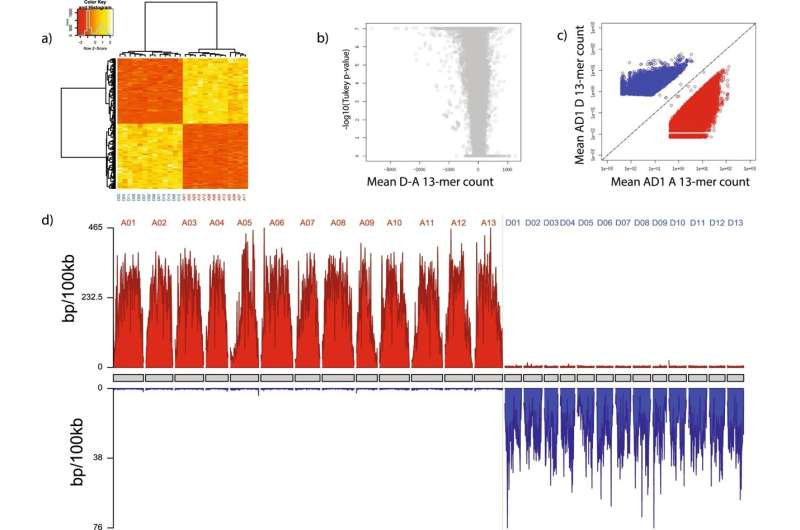This article has been reviewed according to Science X's editorial process and policies. Editors have highlighted the following attributes while ensuring the content's credibility:
fact-checked
peer-reviewed publication
trusted source
proofread
New method traces ancestry of hybrids

If you've ever kept a garden, you're probably familiar with hybrids, from disease-resistant tomatoes to Stargazer lilies.
Hybrids—common in agriculture as well as in nature—have chromosomes from two or more parent species. In some cases, including strawberries, goldfish and several other species, these disparate parental chromosomes become doubled, a condition known as allopolyploidy.
In "Transposon signatures of allopolyploid subgenome evolution," a recent article published in the journal Nature Communications, Binghamton University Assistant Professor of Biological Sciences Adam Session and Daniel S. Rokhsar, a professor of genetics, evolution and development at the University of California, Berkeley, outline a way to trace these genomes back to the polypoid hybrid's parent species.
Unlike previous methods, which use comparison with related non-hybrid species to decipher polypoid ancestry, the authors' method allows them to discover distinct ancestries by looking at genomic patterns in the hybrid itself.
"Each ancestral genome carries a unique set of repetitive elements," Session explained. "So if we find sets of chromosomes in a polypoid that carry different repetitive elements, that proves hybrid ancestry and allows us to figure out which chromosomes were inherited together coming from the various progenitor species."
In the article, they apply the method to some well-studied cases of polyploid hybrids, such as tobacco, cotton and cyprinid fish, such as goldish and carp. They also use it to tease out the disputed ancestries of other hybrids, including false flax and strawberries.
"In many cases, the ancestors of living polyploids are not known. Using our method, we can figure out the ancestral origin of different chromosomes just by studying the polyploid genome itself, and divide the chromosomes into sets, or 'sub-genomes,' derived from its various ancestors," he said. "In addition to identifying the subgenomes, we can also tell you the order in which they were put together."
Polyploidization—the duplication of genomes in a hybrid that stabilizes its ancestry—is much more common in plants than animals, since plants can better tolerate multiple copies of their genomes, Session explained. The process of polyploidization is more involved with animal species, although it does happen in some fish and amphibians. In the case of goldfish, the authors prove for the first time that they share the same duplicated gene sequences as common carp, and thus a common hybrid ancestor.
Polyploidy is unknown in mammals, although hybridization is still possible. Take mules, for instance, which are a hybrid between horses and donkeys: Male mules are effectively sterile, although female mules can mate with either parent species. But without genomic duplication, the distinctive hybrid type cannot be stably propagated.
A tetraploid such as cotton has four copies of each chromosome, two from each of two ancestors, while hexaploids—such as false flax—have six chromosomes derived from three parent species. With eight copies of each chromosome, an octoploid such as strawberry ultimately has four ancestral species.
Polyploids have complex biology that is still being deciphered, and figuring out the sub-genome structure of their genomes is a step forward. Over millions of years, the genes contributed by each of the parental species evolve in their new polyploid context. Some redundant genes are lost or inactivated; others can develop new functions or novel interactions with their counterparts in the other sub-genomes.
The new work argues that the order in which parental species are added to the emerging polyploid mix in a higher polyploid like strawberry can have profound impact on how these evolutionary processes occur. Sorting out the impact of these duplicated on the evolving polyploid is an ongoing challenge, the authors said.
"Understanding polyploid genome evolution as a whole is important to the wider field of plant biology," Session said. "Many important crops like maize and emerging biofuel crops like miscanthus and switchgrass are affected by this process, and we hope to take advantage of their genomic flexibility to breed new and improved varieties."
More information: Adam M. Session et al, Transposon signatures of allopolyploid genome evolution, Nature Communications (2023). DOI: 10.1038/s41467-023-38560-z
Journal information: Nature Communications
Provided by Binghamton University


















